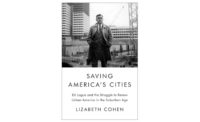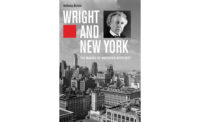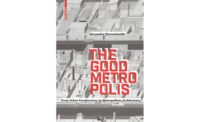Unique among the patriotic anthems of nations, the lyrics to “America the Beautiful” proclaim, “Thine alabaster cities gleam,/ Undimmed by human tears!” The song intriguingly presents a nation where even suffering endemic to the human condition cannot dim the radiance of its settlements. Scoff at the sentimental lyrics dressed in dated language as you will, but that vision still carries political weight and imaginative energy. It’s the perfect song to keep in mind while reading Alex Krieger’s City on a Hill.
This is not because Krieger subscribes to a jingoistic notion of the supremacy of American cities over all others—quite the contrary. Krieger’s focus is on how our nation’s thinkers have reacted positively and negatively to utopian city visions. A practicing architect, planner, and professor, he brings enormous erudition to the promethean task of clarifying the sometimes shadowy role of these visions as he chronicles the ways that they have strongly shaped urban policies and designs. In this carefully argued and cinematically sweeping history, Krieger offers plentiful examples of how romantically perfectionistic ideals have influenced, for better or for worse, the creation of factory towns like Lowell, Massachusetts, and inspired religiously themed settlements like New Harmony, Indiana. In a fresh understanding of New Orleans, Krieger notes that for three centuries its citizens had been sure their town could resist the effects of nature.
The author thoughtfully illuminates the nuances of such dreams, spanning a spectrum from Biblically themed imagery of a city of God (the Massachusetts Bay Puritan colonists’ City on a Hill of the book’s title) to Chicago as the hub of triumphant capitalism. And there is Washington, D.C., Janus-faced, marked by the symbolism and monumentality of the public capital as well as the blight of its depressed neighborhoods.
Krieger is sensitive to backlashes against feverishly high-flown aspirations such as the 1960s’ hippie back-to-the-land movements, which aimed to shift the idea of an American Eden from the city to the countryside. In an insightful reading of New Urbanism, the planning and development movement emphasizing “village-like,” human-scale downtowns that juggle metropolitan amenities with rural neighborliness, Krieger carefully analyzes the Woodlands, near Houston, as an example of that balance.
In a field crowded with detailed histories of this kind, the book stands out as an invigorating study, rich in the history of ideas about what American urban settlements might have been and still may become. “It’ll be a great place if they ever finish it,” quipped O’Henry about New York. But, as Krieger reminds us, no city is ever completed once and for all, so we need to reflect on the key ideas of those who sought more perfect forms of this always imperfect place.







Post a comment to this article
Report Abusive Comment